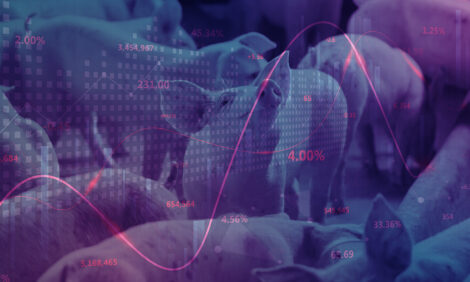



Controversy over Air Quality
By Theo van Kempen, Swine Nutrition Specialist, North Carolina State University - The biggest challenge for the animal industry is likely air quality. Odor may affect the quality of life of those down-wind from a swine farm. Ammonia may contribute to eutrophication. Dust may affect the health of both animals and people, especially in facilities.
 Dr Theo van Kempen Swine Nutrition Specialist |
Air quality has received attention in courts, in legislation, and in many research projects. However, the current picture of how large the problem is and what can be done about it is not very clear. The reason is that the effects of animal production on air quality are hard to quantify and, therefore, hard to control.
Odor, for example, is a subjective observation. Some people like one perfume; others hate it. Some people can smell a flower from a yard away; others have to stick their nose in it to smell anything. These differences between people become even more complicated because such conditions as a runny nose can affect our odor perception drastically. Fortunately, that one condition is easy to check for. However, spicy food, a person's mood, exposure to other odors, etc., all affect odor perception. Under well-controlled research conditions, this variability in odor strength can result in researchers' inability to distinguish sources of odor that are chemically up to two-fold different. In real life, differences many-fold larger may not be noticed.
This situation poses a major hurdle for odor legislation and research. If people can't tell that something is better, even when the emission is halved, based on chemical measures, then why bother? Where swine odor is concerned, the problem becomes even worse because emotional issues are involved.
The alternative is to chemically analyze odor. By using equipment like gas chromatography, it is possible to quantify the compounds that make up odor. For swine odor, there are probably 30 to 50 compounds of major importance to odor perception. However, the total number of compounds likely exceeds 200. This large number poses its own challenges. Currently, there is no agreement as to which compound is the major one causing the strong odor. Also, there is no agreement on how the different compounds or even classes of compounds interact with each other to result in an odor sensation.
The underlying reasons for this are several. First, it is difficult to assess odor, as it requires the human nose. Second, it may well be that odor is not odor. Pigs in Minnesota don't quite smell the same as pigs in North Carolina. But as long as there is no agreement, we will simply end up with large sets of numbers and no conclusions as to what they mean.
For compounds like ammonia, dust, and methane, the problem is more manageable in theory, as they are relatively easy to measure (although there is still no consensus on what methodology to use). In practice, though, emission values that are now available are only rough estimates. North Carolina State University published a report in which different techniques for measuring ammonia were evaluated at the same site, and agreement among the techniques was very poor.
Other factors that cloud on-site measurements are that several sources of odor exist, each of which is hard to characterize. First comes the house. If this is mechanically ventilated, it is relatively easy to measure airflow through each fan and to sample this air. However, if it is naturally ventilated, then it is virtually impossible to quantify how much air moves through the building. Air speed may vary in different parts of the building; air may even enter and exit on the same side of the building, depending on wind. And the air inlets can't be ignored, as background levels of ammonia, methane, and dust should be corrected for.
Emissions will vary greatly throughout the day, as temperature, airflow, and animal activity fluctuate. Over time, animals grow, eat different diets, and increase fermentative activity with age: emission again changes. Seasons change, and emissions change.
As far as odor from manure storage is concerned, we see the same problems here as we do in a naturally ventilated house. It is virtually impossible to measure accurately how much air moves across the surface of a lagoon and thus how much odor or ammonia this air picks up: the airflow is different in different parts of the lagoon, throughout the day, and throughout the year.
Odor from land application is probably the most difficult to measure. Large surfaces need to be considered, as well as very drastic changes in emission over time and tremendous fluctuations due to sun, rain, soil conditions, etc.
Thus, to obtain good-quality data on air-quality issues on swine farms, it will be necessary to measure in all seasons, at all times of the day, and under all possible housing, management, and nutrition regimens. Clearly, each farm is unique when it comes to air quality, and each week the outcome of measurements will be different. This is exactly why the North Carolina Division of Air Quality has such difficulty substantiating claims from neighbors of farms that odor is affecting the quality of their lives.
The Environmental Protection Agency also has recognized the challenges that air-quality regulations will pose. For this reason, it has announced that it is negotiating with farmers to join an effort to quantify air-quality issues. The general concept behind this proposal is that farmers agree to participate in an air-quality monitoring effort by supplying both funds (levied through a fine) and access to farms (28 total across the country, covering all species). Based on the data to be gathered at the 28 test farms, all farms participating will subsequently be regulated under existing rules (maximum emission of ammonia and hydrogen sulfide is 100 pounds per day, which for ammonia is about average on a farm with 3,000 grow/finish pigs, if available data are accurate). All farms will have to apply for all applicable permits. Farms that exceed emission limits will have to notify authorities and install approved methods for reducing emissions.
However, there is an incentive for farms to participate in the program. It is that while they are part of the program, they cannot be sued under the Clean Air Act or the CERCLA Section 103 hazardous substance reporting, as long as the rules are followed.
Efforts like this underscore the importance of keeping air quality in mind, but they also underscore the fact that the current lack of knowledge hampers efforts to reduce and control emissions. Data to be gathered on the 28 farms over 22 months will help, but as this effort covers five species of animals and several distinct production systems, it is questionable whether it will go far enough to help our understanding.
Source: North Carolina State University Swine Extension - December 2003









